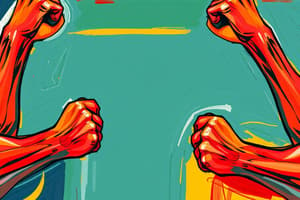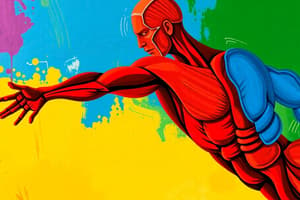Podcast
Questions and Answers
During elbow flexion, if the biceps brachii is the agonist, which muscle serves as the antagonist?
During elbow flexion, if the biceps brachii is the agonist, which muscle serves as the antagonist?
- Brachioradialis
- Brachialis
- Deltoid
- Triceps brachii (correct)
Which muscle shape describes fascicles that converge on a single tendon from a broad origin?
Which muscle shape describes fascicles that converge on a single tendon from a broad origin?
- Convergent (correct)
- Parallel
- Pennate
- Circular
If a muscle is named 'flexor carpi ulnaris', what does 'flexor' indicate about the muscle's function?
If a muscle is named 'flexor carpi ulnaris', what does 'flexor' indicate about the muscle's function?
- The muscle's location within the body
- The muscle's general shape
- The muscle's size relative to other muscles
- The muscle's primary action (correct)
Which class of lever is exemplified by neck extension using the trapezius muscle, where the fulcrum is positioned between the effort and the load?
Which class of lever is exemplified by neck extension using the trapezius muscle, where the fulcrum is positioned between the effort and the load?
What movement primarily results from the contraction of the zygomaticus major muscle?
What movement primarily results from the contraction of the zygomaticus major muscle?
Which of the following muscles is responsible for elevating the hyoid bone and tongue?
Which of the following muscles is responsible for elevating the hyoid bone and tongue?
The deltoid muscle is an example of which type of fascicle arrangement?
The deltoid muscle is an example of which type of fascicle arrangement?
During respiration, which muscle contracts, causing it to flatten and increase the volume of the thoracic cavity?
During respiration, which muscle contracts, causing it to flatten and increase the volume of the thoracic cavity?
Which property allows muscle tissue to shorten and generate force?
Which property allows muscle tissue to shorten and generate force?
Which connective tissue layer directly surrounds individual muscle fibers?
Which connective tissue layer directly surrounds individual muscle fibers?
What is the primary function of the sarcoplasmic reticulum within a muscle fiber?
What is the primary function of the sarcoplasmic reticulum within a muscle fiber?
According to the sliding filament model, what happens to the I band during muscle contraction?
According to the sliding filament model, what happens to the I band during muscle contraction?
Which type of muscle tissue contains cells connected by intercalated discs and is found only in the heart?
Which type of muscle tissue contains cells connected by intercalated discs and is found only in the heart?
Which of the following actions is NOT a primary function of the muscular system?
Which of the following actions is NOT a primary function of the muscular system?
The ability of a muscle to return to its original length after being stretched is known as:
The ability of a muscle to return to its original length after being stretched is known as:
Flashcards
Origin (muscle)
Origin (muscle)
Fixed attachment point of a muscle.
Insertion (muscle)
Insertion (muscle)
Movable attachment point of a muscle.
Agonist (Prime Mover)
Agonist (Prime Mover)
Main muscle responsible for a specific movement.
Antagonist
Antagonist
Signup and view all the flashcards
Synergist
Synergist
Signup and view all the flashcards
Fixator
Fixator
Signup and view all the flashcards
Circular Muscle
Circular Muscle
Signup and view all the flashcards
Convergent Muscle
Convergent Muscle
Signup and view all the flashcards
Parallel Muscle
Parallel Muscle
Signup and view all the flashcards
Pennate Muscle
Pennate Muscle
Signup and view all the flashcards
Superior Rectus
Superior Rectus
Signup and view all the flashcards
Lateral Rectus
Lateral Rectus
Signup and view all the flashcards
Inferior Oblique
Inferior Oblique
Signup and view all the flashcards
Skeletal Muscle
Skeletal Muscle
Signup and view all the flashcards
Smooth Muscle
Smooth Muscle
Signup and view all the flashcards
Study Notes
Muscle Definitions and Examples
- Origin refers to the fixed attachment point of a muscle.
- As an example, the scapula represents the origin for the biceps brachii.
- Insertion refers to the movable attachment point of a muscle.
- As an example, the radius represents the insertion for the biceps brachii.
- The agonist, or prime mover, signifies the main muscle responsible for a movement.
- As an example, the biceps brachii acts as the agonist in elbow flexion.
- The antagonist is the muscle that opposes the agonist.
- As an example, the triceps brachii serves as the antagonist during elbow flexion.
- The synergist assists the agonist.
- As an example, the brachialis acts as a synergist with the biceps brachii.
- The fixator stabilizes the origin of the agonist.
- As an example, rotator cuff muscles function as fixators during arm movements.
Fasciculus Orientation and Muscle Shapes
- Circular muscles feature fascicles arranged in rings.
- The orbicularis oculi serves as an example of a circular muscle.
- Convergent muscles have a broad origin converging to a single tendon.
- The pectoralis major exemplifies a convergent muscle.
- Parallel muscles exhibit fascicles that run parallel to the long axis.
- The sartorius is an example of a parallel muscle.
- Pennate muscles have fascicles attaching obliquely to a tendon.
- Unipennate muscles, such as the extensor digitorum longus, represent one subtype.
- Bipennate muscles, like the rectus femoris, represent another subtype.
- Multipennate muscles, such as the deltoid, represent another subtype.
Muscle Naming Rules
- Muscle names often reflect their location.
- As an example, the temporalis muscle is named for its proximity to the temporal bone.
- Muscle names often reflect their shape.
- As an example, the deltoid muscle has a triangular shape.
- Muscle names often reflect their action.
- As an example, the flexor digitorum muscle flexes the fingers.
- Muscle names often reflect their size.
- As an example, the gluteus maximus is the largest of the gluteal muscles.
Classes of Levers
- First-class levers have the fulcrum positioned between the effort and the load.
- Neck extension using the trapezius exemplifies a first-class lever.
- Second-class levers have the load positioned between the fulcrum and the effort.
- Standing on toes using the gastrocnemius exemplifies a second-class lever.
- Third-class levers have the effort positioned between the fulcrum and the load.
- The biceps brachii in elbow flexion exemplifies a third-class lever.
Neck Muscles
- The sternocleidomastoid originates at the sternum and clavicle and inserts at the mastoid process, flexing and rotating the head.
- The scalenes originate at the cervical vertebrae and insert at the first two ribs, elevating the ribs and assisting in neck flexion.
Head Movements
- The sternocleidomastoid facilitates flexion.
- The splenius capitis facilitates extension.
- The sternocleidomastoid and scalenes facilitate rotation.
Facial Expression Muscles
- The zygomaticus major facilitates smiling.
- The corrugator supercilii facilitates frowning.
- The buccinator facilitates cheek compression.
Mastication, Tongue Movement, and Swallowing
- Mastication involves the masseter and temporalis muscles.
- Tongue movement involves the genioglossus and styloglossus muscles.
- Swallowing involves the pharyngeal constrictors and suprahyoid muscles.
Hyoid Muscles
- The mylohyoid elevates the hyoid bone and tongue.
- The sternohyoid depresses the hyoid bone after swallowing.
Eye Movement Muscles
- The superior rectus elevates the eye.
- The lateral rectus abducts the eye.
- The inferior oblique elevates and laterally rotates the eye.
Vertebral Column Muscles
- The erector spinae group extends and flexes the spine.
- The multifidus stabilizes the vertebrae.
Thorax Muscles
- The diaphragm serves as the primary muscle of respiration.
- The external and internal intercostals assist in breathing.
Characteristics of Muscle Tissue
- Skeletal muscle is voluntary, striated, features multinucleated cells, and attaches to bones for movement and posture.
- Smooth muscle is involuntary, non-striated, has spindle-shaped cells, and is found in organ and vessel walls for digestion and circulation.
- Cardiac muscle is involuntary, striated, contains single-nucleus cells, is exclusively in the heart, and connects via intercalated discs for synchronized contractions.
Functions of the Muscular System
- Movement, such as walking and breathing
- Support and posture maintenance
- Protection of organs
- Heat generation via metabolism
- Blood circulation through cardiac muscle action
Functional Properties of Muscle Tissue
- Excitability involves the ability to respond to stimuli.
- Contractility involves the ability to shorten to generate force.
- Extensibility involves the ability to stretch without damage.
- Elasticity involves the ability to return to the original shape after stretching.
Connective Tissue Components of Skeletal Muscle
- The epimysium surrounds the entire muscle.
- The perimysium encloses fascicles.
- The endomysium surrounds individual muscle fibers.
Blood Supply and Innervation
- Skeletal muscles have a rich blood supply for nutrients and oxygen.
- Motor neurons innervate skeletal muscles for triggering contraction.
Origin of Muscle Fibers and Hypertrophy
- Muscle fibers originate from myoblast fusion during development.
- Hypertrophy occurs through increased protein synthesis in response to resistance training or stress.
Components of a Muscle Fiber
- Sarcolemma serves as the membrane.
- Sarcoplasmic reticulum provides calcium storage.
- Mitochondria produces ATP.
- Myofibrils are contractile units.
- Nuclei are present in muscle fibers.
Types of Myofilaments
- Actin (thin filament) contains binding sites for myosin.
- Myosin (thick filament) has heads for cross-bridge formation during contraction.
Sarcomere Diagram
- Sarcomeres contain alternating actin and myosin filaments arranged in repeating units.
- Z-discs mark sarcomere boundaries.
Sliding Filament Model & Band Changes
- During contraction, the A band remains constant.
- During contraction, the I band shortens.
- During contraction, the H zone disappears as filaments slide past each other.
Resting Membrane Potential
- Generated by ion gradients (Na+/K+) across the sarcolemma.
- Maintained by Na+/K+ pumps.
Studying That Suits You
Use AI to generate personalized quizzes and flashcards to suit your learning preferences.




